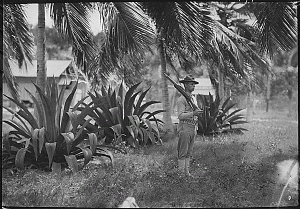Thoughts on Building the Base
National Dialogue and Traveling Exhibit
For the Guantánamo Public Memory Project, we are examining the building of the base from approximately 1903 to 1964. Two things especially impress me in the research that we’ve done so far. First, how the landscape of Guantánamo Bay has been used and imagined by human beings and how uses and visions for the place have changed from pre-Columbian to present times. Second, how challenging it is to remove oneself from contemporary popular meanings of the base in considering its construction—i.e. how our understandings of the base as associated with the War on Terror and torture complicate the historical task of considering the past on its own terms.
On the first subject: I approach our topic as an environmental historian. As such, I was fascinated by the idea of the Bay as a place of sustenance and connection for indigenous peoples before the arrival of Europeans, how colonial eyes re-imagined it as a natural commercial port, by what the collision of Native American and European worlds meant for the bay, the land that surrounded it, and the people who called it home, and by the sudden change that came with the imposition of an American base after 1903. When he made contact with the bay in 1494, Columbus made the somewhat-suspect claim that the area was deserted and named it “Puerto Grande” or grand port. Likely a factor of geography, the Spanish chose to develop their ports elsewhere in spite of this enthusiastic naming and Guantánamo’s deep, navigable channels. Not until the 1880s did another foreign power, its aspirations for empire thinly cloaked behind a strategy of creating “spheres of influence,” give it new meaning. The rest, I suppose, is history. Yet, I am haunted by the top-down image of the straight lines and right-angle corners of the modern base perimeter cutting across and through mountain ridges, watersheds and now-ancient animal and human trails that that connected from the water’s edge and the interior (see Google Maps image: http://goo.gl/maps/rtjWE).
On the second: I am impressed by how the gravity of the current meanings we give GTMO seems to pull all aspects of its previous history from their moorings—as if the present situation somehow reaches backward through time and warps historic meanings of the place as it marched toward the inevitable present. Historians of the Civil War and other pivotal moments in American and world history talk about the need to resist this force. They encourage us to try to imagine the range of opportunities historical agents had when they made decisions with no possible knowledge of how the story would end. Even in doing something as seemingly simple as telling the story of how the base was built, it is difficult to escape this force of the present.
Posted by Cody Ferguson, Postdoctoral Scholar at Arizona State University
Arizona State University is participating in the Guantánamo Public Memory Project‘s National Dialogue and Traveling Exhibit. Opening at NYU’s Kimmel Center for University Life Windows Gallery in December 2012 and traveling to 9 sites (and counting) across the country through at least 2014, the exhibit will explore GTMO’s history from US occupation in 1898 to today’s debates and visions for its future. The exhibit is being developed through a unique collaboration among a growing number of universities as a dialogue among their students, communities, and people with first-hand experience at GTMO.

